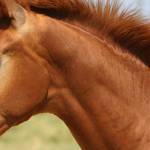Gastric Ulcers in Young Horses

Equine gastric ulcer syndrome has been found in significant percentages of racehorses, performance horses in other disciplines, and even in some populations of pasture-kept horses. Various factors including digestive acid irritation, intense exercise, nutritional regimens, racing, stall confinement, and use of nonsteroidal anti-inflammatory drugs have been blamed for gastric ulcer formation. Stress of any type may also be a contributing cause. In two studies conducted in Germany and reported at the 7th European Workshop on Equine Nutrition, researchers looked at the influence of three different forage-based diets on gastric ulceration in young horses stressed by abrupt weaning.
At the beginning of the research, 89 Warmblood foals of both sexes and aged 165 to 201 days were examined by endoscope to evaluate the presence of gastric ulcers. The foals were then weaned and were divided into five dietary treatment groups.
In the first trial, three groups of weanlings were fed either unmolassed alfalfa (lucerne) chaff ad libitum, oats, and a mineral supplement; hay ad libitum and a mixture of corn silage, grass silage, oats, soybean meal, and a mineral supplement; or hay ad libitum along with oats and a mineral supplement. In the second trial, the remaining two groups of weanlings were fed either molassed alfalfa chaff ad libitum, oats and a mineral supplement, or with hay ad libitum, oats, and a mineral supplement. All weanlings were bedded on straw during both trials. Feed intake was measured daily, and body weight and condition were measured at intervals.
At the initial ulcer screening, ulceration was found in 62% of foals that were to participate in the first trial and 95% of foals that were to participate in the second trial. Ulceration scores reflected both the presence and severity of ulceration. After the foals were weaned and had completed the feeding trials, scores increased in all groups, especially for the weanlings that were fed alfalfa chaff. Higher scores were the result of more lesions and increased lesion severity. Feed intake was not affected by gastric lesions, and there was no significant correlation between ulcer severity, body weight, or condition score.
It was not possible to evaluate the absolute effect of weaning stress in these studies, though it may have contributed to the rise in ulceration scores. Worsening of gastric lesions could have been related to mechanical injury from feed particles or the chopped edges in the alfalfa chaff. The researchers suggested that mixing oats into different types of forages such as grass silage, corn silage, and hay could support gastric mucosal health in weanlings.








